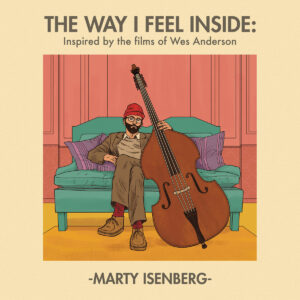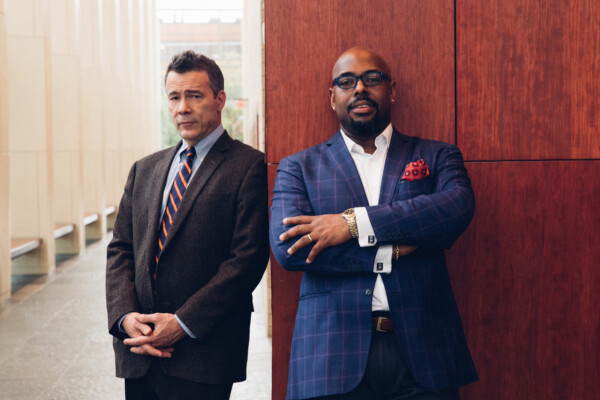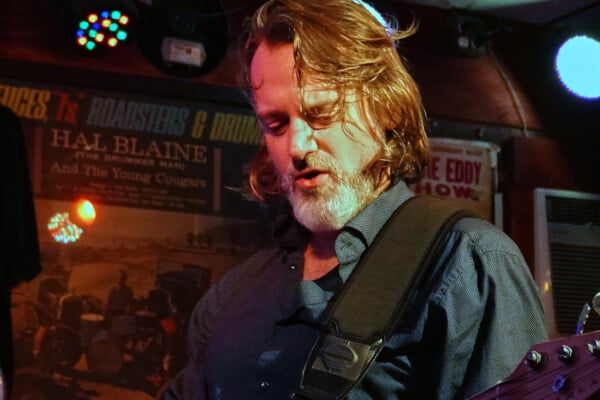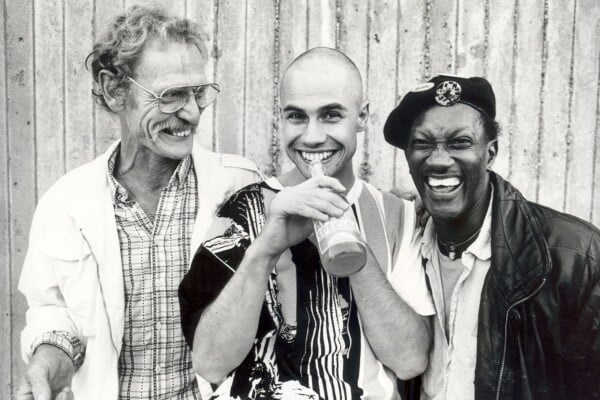The Way I Feel Inside: An Interview with Marty Isenberg

Wes Anderson’s use of music in his films is masterful. He can take a popular song you’ve heard hundreds of times and place it in just the right scene to give both the film and song new layers of emotion. Bassist Marty Isenberg took inspiration from that depth and catalog for his debut solo album, The Way I Feel Inside.
Based in New York City, Isenberg has had a broad career in the music scene, from jazz to classical to theater and contemporary music. It’s from this diverse mix of sounds that he created the arrangements for the album, which features songs like Elliott Smith’s “Needle in the Hay” to David Bowie’s “Rebel Rebel” to Nico’s version of “These Days.” The bassist calls it a kind of personal mixtape.
 “A mixtape is a personal, intimate reflection of what we want to show others about ourselves, and this album is my own spin on that concept—a journey into my inner life through this collage of meaningful music, in my own voice as a composer and a jazz musician,” he says.
“A mixtape is a personal, intimate reflection of what we want to show others about ourselves, and this album is my own spin on that concept—a journey into my inner life through this collage of meaningful music, in my own voice as a composer and a jazz musician,” he says.
“It’s an album inspired by the songs and media that expressed how I felt in my younger years, but it is not a replication of that media. It’s a series of diary entries, a statement about identity and culture, and an exploration of genre and style.”
We caught up with Isenberg to talk about the music, his incredible arrangements, and stepping into the role of musical leader.
The Way I Feel Inside is available now on digital formats, including iTunes and Amazon MP3.
I’ve been listening to The Way I Feel Inside for a few months. I was lucky enough to get it ahead of time, and I really love it. I wanted to start out by asking what is your favorite Wes Anderson film?
Ooh, that’s a gotcha question right there. My favorite films are the first Wes Anderson films that I experienced, and that was The Royal Tenenbaums, number one. I guess Rushmore is in there too, but for me, the two favorites are The Royal Tenenbaums and Life Aquatic.
There’s something special about how he uses music in his films. How did your interest in this evolve?
I saw his movies for the first time in my formative years, high school age. I was captivated by the experience of his movies, the way he tells his stories, and the themes of alienation and stagnant growth, all through this very witty lens – these sorts of heroic nerds struggling with masculinity or redefining masculinity in some ways. And then he curates that experience and those feelings through this incredible collage of sound and visuals. Experiencing the songs from those movies with bands like The Velvet Underground and Elliott Smith and David Bowie with that added feeling of the experience of this movie… I probably would have fallen in love with those songs anyway, but just from that experience I had with them, these songs in his movies are just my comfort songs that I just come back to over and over again.
I read that this started during the pandemic. You arranged one song, and then it grew from there. Is that right?
Yeah, that’s basically what happened. I’ve been thinking about these songs for a really long time, and I’ve tried to write arrangements for them in the past. It was during the pandemic when everything shut down, and I had some time to write music. We were putting together little virtual concerts just to do something, and I made a video for “Stephanie Says,” the Velvet Underground song. It was really fun. It felt like it was coming from a very organic place for me. I posted online, and I said, “Hey, wouldn’t it be kind of cool if I did something like an album with a Wes Anderson kind of concept to it?” And people said that’s a great idea. You should do that. And so that was the beginning of that process for me.
Going back to what you said about how seeing the songs in the films, it adds this whole other dimension to how you think and feel about them. I’m wondering how that affected the way you arranged each piece. What was your approach to arranging them?
I started with each piece independent of thinking about them in a Wes Anderson concept. I just got into them and tried to make surprising things happen, tried to make a section that we could improvise in that felt like a game within itself. A lot of the challenge of arranging pop music for jazz sometimes is that it’s not always interesting to just play jazz solos over three chords or something like that. So making an interesting solo section is a challenge and an important part of how I wanted to approach this music.
Once I had sort of the individual pieces somewhat arranged, I wanted to think about how to make this overall concept of the album. And that’s when I integrated more of the Wes Anderson-ian sounds into the album. For instance, we took our arrangement of “Stephanie Says” and started adding Harpsichord and mandolin, sort of referencing Mark Mothersbaugh’s arrangements. The music in The Grand Budapest Hotel is all mandolin and lute concertos. So I took those elements and then made them part of the songs themselves. Same thing with “The Way I Feel Inside.” Again, I started using some of that underscoring to become part of the arrangement.
That’s another great arrangement you made, as the original has little to no harmonic information. Did you study arranging, or is that something you just picked up over time?
I did. My first college was the New School, and I went there as a composition major in a program that had five composition majors and like 200 jazz performance majors. I always felt a little bit insecure and out of place there because, first of all, all jazz musicians write music. Jazz composers tend to perform music, but we’re sort of on these different tracks that have been separated for whatever reason. So during college, one of the things I did was I put together this really, really big band. I had a 13-piece band, and that was sort of how I stepped out of this… Or maybe that’s how I overcompensated for what I was experiencing. But it was actually really awesome because we were able to rehearse like every Sunday at the New School. At that age, you know, we were just ready. We just wanted to play music and to be able to do that for basically free was a great experience. I started to really hone my style as a writer and as an arranger during that time. I think one of my strengths is maybe arranging to the point maybe more so than composing sometimes, but I’m very into big band arrangers and I take that concept to my small combo vibe. So that’s my background in arranging.
Do you feel that your sense of composition and arranging affect your improvising as far as your note choices or rhythms that you’re playing? Like you’re trying to think larger scale whenever you’re improvising?
I do think so. I don’t think that when I’m improvising, I’m necessarily always conceptualizing it in a macro way. When you’re improvising you’re just sort of feeling, you know, or at least that’s what I do. Certainly, when I’m in the practice room, I think about editing and trying to be concise. Some of my favorite bass players play that way: Larry Grenadier, Charlie Haden. I mean, those are the people that really excite me – those people that have a very melodic and concise storytelling aspect to their playing.
I think that’s all in there, and working on my writing and composition chops and having those aesthetic preferences for music that develops and is concise… it certainly is knocking around in the back of my brain, but I will defer to what other people think about my playing because once I’m doing it, I’m just kind of doing it.
But I think you’ve certainly picked up on something that is present in my process. I’m thinking about trying to make something make sense in the big picture when I’m improvising.
What kind of advice would you have for people wanting to start arranging? There are lots of great arrangers that are bassists.
If we’re talking about arranging specifically and not necessarily composing, I didn’t come prepared with all the books I might recommend, although there certainly are some I could think of. As with everything in music, the way you learn is just to dive in and do it, you know? I think that there are two aspects to that in just listening to great arrangers and finding what you like and what resonates with you. And there are a thousand different ways to do it. That’s sort of the interesting and fun thing. There are the traditional rules of arranging that you need to learn, and there are classes and books and stuff for that. More important is finding what sounds good to you and what fascinates you, and then just doing it and making mistakes.
Just start arranging and put it in front of other people, and they will tell you what needs to be fixed. I mean, that is a free service that other musicians will do for you, and it’s something you never forget it.
I think my favorite track on the album is “Needle in the Hay.” That was one of the tunes that once I heard it in The Royal Tenenbaums, I just listened to a million times. It’s so heavy, and you bring a lot of weight to it, too. Could you start by talking about crafting the solo bass intro?
Well, first of all, thank you. I had the same experience with that song. I’ve loved it since I first heard it. After that movie, I checked out a bunch of other Elliott Smith stuff, and they’re some of my favorite albums. He’s such an amazing and singular voice.
As for the intro, I basically took the guitar riff and put it on the bass. That is where this arrangement began, and so then I just needed to get from point A to point B, and I wanted to do something with the bass up front because this is a song that features the bass. Gosh, what did I do? I don’t know, I just wanted to move from a couple of different harmonic locations and get to the riff in a way that I’m playing some double stops and slapping and popping on the bass a little bit. And yeah, I think that’s basically how that intro kind of came together.
Again, the way that you arranged it builds up a couple of times and drops down to like just the kind of lonely, distraught electric guitar. The way that you use the arrangement to evoke the emotions that come with the song and from the film is just pretty amazing.
Thank you. It’s very cool to get some feedback like that. And when I’ve seen some of the other reviews and people where they get the concept, it really is very satisfying. It means that it doesn’t just exist in my head. Then that is exciting to me. So I appreciate that.
There are so many bass players that don’t become a band leader or don’t put out their own album. What was your takeaway from the experience? I know you ultimately you’re happy with it, but what kind of obstacles did you have that you had to overcome?
First is just the weight of doing it – the pressure and the scheduling and the cost and the rehearsing and all that is a lot. It’s a lot to deal with. And it kind of doesn’t stop, as in the album’s done, but I’m still in this process of trying to get the music out there and making appearances and trying to get reviews and then sort of leveraging all that to hopefully get more gigs down the road. It’s a never-ending motion machine, which is good for the social media age because you always have to have something to talk about, you know? So that is helpful but also stressful and can take away from practicing or whatever else you have going on in your life.
I think that the struggle I had with it was just letting a final product be made because I’m someone that [feels] art is never really done. You can always change it or make it better. So you have all these limitations on how many rehearsals you can have, and then you get into the studio, and you can get what you can get there. But then you might want to make some changes. There were little things I changed after we were actually in the recording. I ended up adding a little bit more harpsichord to the first track, so I had to call my friend Dallas, who lives in Utah, to overdub a little bit more. I also added some more trumpet to “The Way I Feel Inside.” And there are still a few things on the album. It’s like, “Ah, I wish I had caught that.” But for the most part, it’s very satisfying to have it be a finished thing. As musicians, we’re just constantly making music and throwing it away. It just happens, and then it’s gone. To take a moment in my life, which is just a moment in my life, and say this moment is valuable and is what I want to say artistically is really interesting from that perspective of someone that plays music all day and then it’s gone.
Are you envisioning another album for yourself?
Absolutely. I don’t have a concept yet together of what it’s going to be, and I don’t know when it’s going to be, but I definitely [will have another]. I know that my next album will be an album of all original music. That is the second album, the sophomore album concept.



